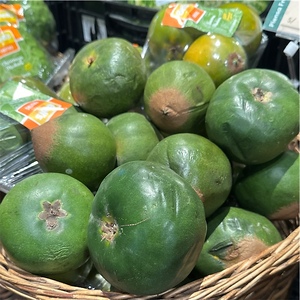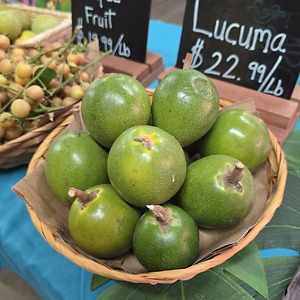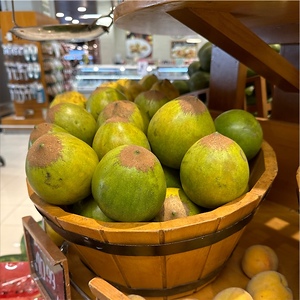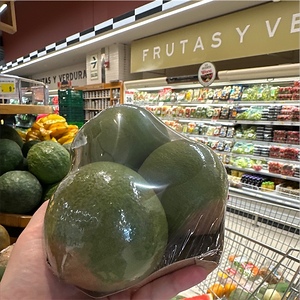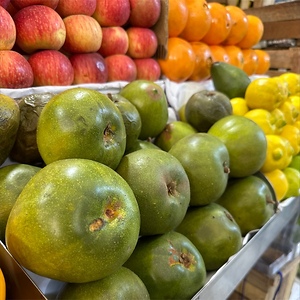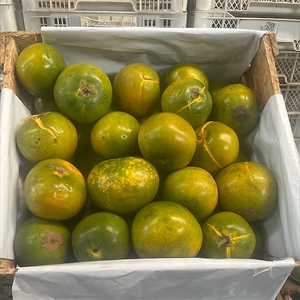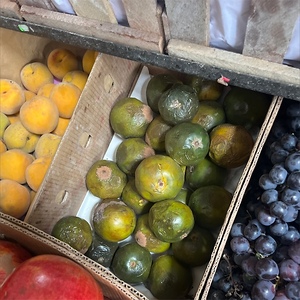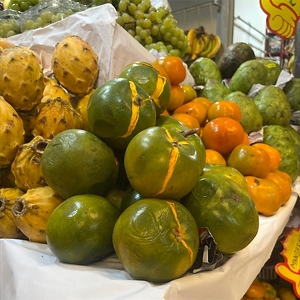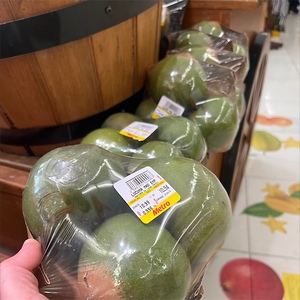

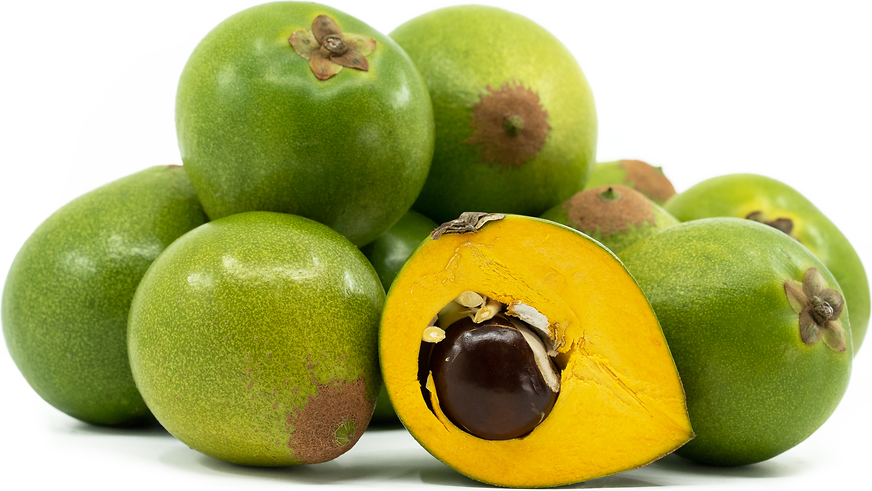
Lucuma
Estimated Inventory, lb : 0
Description/Taste
Lucuma is generally small in size, averaging 7 to 10 centimeters in length and 4 to 6 centimeters in diameter, and has an oblate, oblong, or round shape, tapering to a point on the non-stem end. The fruits range from 90 to 160 grams in weight and feature a distinct wring of brown, dry, wrinkled flesh around the apex or tip of the fruit. The fruit’s skin is thin, taut, and firm when young, softening and becoming delicate with maturity. The skin showcases brown, green, and yellow-green hues and sometimes has a faint white to light green speckling. Underneath the surface, the golden yellow flesh can be firm, dense, dry, or soft, depending on the variety and maturity. Ripe Lucuma generally has a powdery, crumbly, and starchy consistency. Many consumers liken it to the texture of cooked egg yolk. The flesh also encases 1 to 5 brown, smooth, and glossy seeds in the center of the flesh. Lucuma is edible raw once ripe, but the flesh is preferred in a paste or powdered form for culinary preparations. The flesh has a rich, sweet, and sugary taste with sweet potato, maple syrup, butterscotch, and caramel nuances.
Seasons/Availability
Lucuma is available year-round.
Current Facts
Lucuma, botanically classified as Pouteria lucuma, is a South American species belonging to the Sapotaceae family. The fruits grow on evergreen trees reaching 8 to 15 meters in height and have been historically foraged as a food source since ancient times. Lucuma trees are productive, producing between 200 and 500 fruits per year, and each fruit takes around 8 to 9 months to ripen after pollination. Many varieties of Lucuma are found worldwide in the present day, and the fruits are known under regional names like Lucumo in Peru, Louma, Lucma, Lucmo, Logma, and Lohma in Ecuador, and Rucma or Maco in Colombia. Lucuma can be categorized into two subgroups known as hard or silk fruits. The version most commonly sold in fresh markets belongs to the silk fruit subgroup, or Lucuma de Seda, as the flesh is softer, sweeter, and more palatable. Lucuma is primarily grown in South America for processing into powders and frozen pastes. This powder has been internationally marketed as a sugar substitute and is increasing in popularity for its naturally sweet, caramel-like flavoring.
Nutritional Value
Lucuma is a source of fiber to aid digestion and vitamins B and C to assist the body in energy production while strengthening the immune system. Lucuma also provides potassium to balance fluid levels within the body, calcium and phosphorus to support bone and teeth health, and magnesium to control nerve functions. Other minerals include iron to develop the protein hemoglobin for oxygen transport through the bloodstream and zinc to help build cells and tissues. In South America, Lucuma has been celebrated for its antioxidant content, helping to reduce inflammation, guard against free radical damage, and protect the body's overall health.
Applications
Lucuma has a rich, sweet, and maple-like taste suited for fresh and cooked culinary preparations. The fruits must be consumed ripe and are not commonly eaten out of hand due to their crumbly, drier flesh. Lucuma is primarily blended and dried into a powder or frozen into a pulp. The powder is used as a sugar substitute and is often added to cakes, cookies, and muffins. Lucuma powder can also be used to thicken soups or added to yogurt and oatmeal. In Peru, Lucuma is a favorite ice cream flavor and is frequently blended with milk or fruit juice to make a shake or smoothie. It is also combined to create a rich dipping sauce for churros or a topping over dulce de leche. In addition to powders, Lucuma can be cooked into a paste for pie and other pastry fillings or used to flavor jams, syrups, and preserves. Savory recipes include using the paste for ravioli. Lucuma pairs well with fruits such as bananas, lemon, pineapple, strawberries, and blueberries, cinnamon, vanilla, and nuts such as cashews, almonds, macadamia, and peanuts. Whole, unopened Lucuma can be ripened at room temperature for 1 to 5 days or a few weeks, depending on the maturity of the fruit when it was harvested. Once ripe, the fruit can be kept in the refrigerator for a few days. The flesh can also be frozen for extended use.
Ethnic/Cultural Info
In Peru, Lucuma is called the “Gold of the Incas” and has been deeply intertwined into the cultural and spiritual lore of indigenous people groups. The Incas considered Lucuma a symbol of longevity and fertility, and several legends connect the tree to the creation, Andean goddesses, and love. Some varieties of Lucuma grown in Peru are entirely golden yellow, including their skin, and these fruits were once connected to the worship of the sun. The Incas believed the fruit absorbed the sun’s rays during sunrise and held special, spiritual gifts. Other theories connect the golden fruits to the Spanish. Legend states that during the Inca conquest, the Spanish believed eating the gold-colored fruits would help them grow closer to finding “El Dorado,” the mythical city of gold. Beyond mythology, archeologists have discovered images of Lucuma on ceramics at burial sites of the Moche people, an indigenous Andean civilization that dates back to the 1st century CE, further establishing the fruit’s prominence in daily life.
Geography/History
Lucuma is native to the Andean region, spanning across Chile, Ecuador, Bolivia, and Peru, and has been growing wild since ancient times. The species naturally grows between 1500 and 3000 meters in elevation in South America and was revered by indigenous populations as a food source. It is unknown when Lucuma was selected for cultivation, but the species was eventually domesticated and bred for improved flavor, texture, and size. Lucuma was first documented in written records in 1531 by European explorers, and over time, the species was spread through human migration to Colombia and other parts of South America. In the early 20th century, Lucuma expanded its cultivation to regions of Central America, notably Costa Rica, and was brought to the United States Department of Agriculture for experimental plantings in Florida and California. In 1973, Lucuma was planted in New Zealand, but never became an extensively cultivated crop. Today, Lucuma is primarily cultivated in Central and South America and is grown on small scales in the United States, Mexico, Australia, New Zealand, and parts of Asia. When in season, fresh fruits are sold through local markets and select wholesalers. Lucuma is also blended and dried into a powder for worldwide sale.
Recipe Ideas
Recipes that include Lucuma. One
| Group Recipes |
|
Lucuma Cheesecake |
| Global Table Adventure |
|
Peruvian Tiramisu |
| Thrive Market |
|
Superfood Lucuma Amps Up This Delicious Eggnog |
| Unconventional Baker |
|
Cashew Lucuma Fudge |



